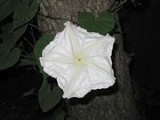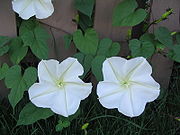
Ipomoea alba
Encyclopedia
Ipomoea alba, sometimes called the moonflower (but not to be confused with the other species also called moonflower
) or moon vine, is a species of night-blooming morning-glory
, native to tropical and subtropical regions of the New World
, from northern Argentina
north to Mexico
and Florida
. Though formerly classified as genus Calonyction, species aculeatum, it is now properly assigned to genus Ipomoea, subgenus Quamoclit, section Calonyction.
It is a perennial
herbaceous
liana
growing to a height of 5-30 m tall with twining stems. The leaves
are entire or three-lobed, 5-15 cm long, with a 5-20 cm long stem. The flower
s are fragrant, white or pink, and large, 8-14 cm diameter. The flowers open quickly in the evening and last through the night, remaining open until touched by the morning sun. On overcast days, the blossoms may remain open for longer. The flowers also tend to remain open longer during cool temperatures - which may also cause the segments to snag or tear as they open.
The name Moonflower derives from their blooming in the evening and their being round in shape like a full moon.
 The ancient Mesoamerican civilizations used the Ipomoea alba morning glory to convert the latex
The ancient Mesoamerican civilizations used the Ipomoea alba morning glory to convert the latex
from the Castilla elastica
tree and the guayule
plant to produce bouncing rubber
balls. The sulfur
in this morning glory served to vulcanize the rubber, a process pre-dating Charles Goodyear
's discovery by at least 3,000 years.
for its flowers. In areas too cold for winter survival, it can be grown as an annual plant
. Since it is of tropical origin, it flowers best under a summer short day photoperiod. Though it can be successfully flowered in the north, its flowering is impaired by excessively long summer days. Thus, it often does not set buds and bloom until early autumn when daylight length is once again near 12 hours. Propagation is usually by seed. The seed resembles a small brownish nut, and should be nicked with a file and then soaked overnight before planting. In some areas it is an invasive species
which can cause problems in agricultural settings.
Moonflower
- Plants :A common name for several night-blooming plants, some with white flowers, including:* Nightblooming cereus species, including Hylocereus.* Datura species, including D. inoxia...
) or moon vine, is a species of night-blooming morning-glory
Ipomoea
Ipomoea is the largest genus in the flowering plant family Convolvulaceae, with over 500 species. Most of these are called "morning glories", but this can refer to related genera also. Those formerly separated in Calonyction are called "moonflowers"...
, native to tropical and subtropical regions of the New World
New World
The New World is one of the names used for the Western Hemisphere, specifically America and sometimes Oceania . The term originated in the late 15th century, when America had been recently discovered by European explorers, expanding the geographical horizon of the people of the European middle...
, from northern Argentina
Argentina
Argentina , officially the Argentine Republic , is the second largest country in South America by land area, after Brazil. It is constituted as a federation of 23 provinces and an autonomous city, Buenos Aires...
north to Mexico
Mexico
The United Mexican States , commonly known as Mexico , is a federal constitutional republic in North America. It is bordered on the north by the United States; on the south and west by the Pacific Ocean; on the southeast by Guatemala, Belize, and the Caribbean Sea; and on the east by the Gulf of...
and Florida
Florida
Florida is a state in the southeastern United States, located on the nation's Atlantic and Gulf coasts. It is bordered to the west by the Gulf of Mexico, to the north by Alabama and Georgia and to the east by the Atlantic Ocean. With a population of 18,801,310 as measured by the 2010 census, it...
. Though formerly classified as genus Calonyction, species aculeatum, it is now properly assigned to genus Ipomoea, subgenus Quamoclit, section Calonyction.
It is a perennial
Perennial plant
A perennial plant or simply perennial is a plant that lives for more than two years. The term is often used to differentiate a plant from shorter lived annuals and biennials. The term is sometimes misused by commercial gardeners or horticulturalists to describe only herbaceous perennials...
herbaceous
Herbaceous
A herbaceous plant is a plant that has leaves and stems that die down at the end of the growing season to the soil level. They have no persistent woody stem above ground...
liana
Liana
A liana is any of various long-stemmed, woody vines that are rooted in the soil at ground level and use trees, as well as other means of vertical support, to climb up to the canopy to get access to well-lit areas of the forest. Lianas are especially characteristic of tropical moist deciduous...
growing to a height of 5-30 m tall with twining stems. The leaves
Leaf
A leaf is an organ of a vascular plant, as defined in botanical terms, and in particular in plant morphology. Foliage is a mass noun that refers to leaves as a feature of plants....
are entire or three-lobed, 5-15 cm long, with a 5-20 cm long stem. The flower
Flower
A flower, sometimes known as a bloom or blossom, is the reproductive structure found in flowering plants . The biological function of a flower is to effect reproduction, usually by providing a mechanism for the union of sperm with eggs...
s are fragrant, white or pink, and large, 8-14 cm diameter. The flowers open quickly in the evening and last through the night, remaining open until touched by the morning sun. On overcast days, the blossoms may remain open for longer. The flowers also tend to remain open longer during cool temperatures - which may also cause the segments to snag or tear as they open.
The name Moonflower derives from their blooming in the evening and their being round in shape like a full moon.
Historical use

Latex
Latex is the stable dispersion of polymer microparticles in an aqueous medium. Latexes may be natural or synthetic.Latex as found in nature is a milky fluid found in 10% of all flowering plants . It is a complex emulsion consisting of proteins, alkaloids, starches, sugars, oils, tannins, resins,...
from the Castilla elastica
Castilla elastica
Castilla elastica, the Panama Rubber Tree, is a tree native to the tropical areas of Mexico, Central America, and northern South America. It was the principal source of latex among the Mesoamerican peoples in pre-Columbian times...
tree and the guayule
Guayule
Parthenium argentatum, commonly known as the Guayule , is a flowering shrub in the aster family, Asteraceae, that is native to the southwestern United States and northern Mexico. It can be found in the US states of New Mexico and Texas and the Mexican states of Zacatecas, Coahuila, Chihuahua, San...
plant to produce bouncing rubber
Rubber
Natural rubber, also called India rubber or caoutchouc, is an elastomer that was originally derived from latex, a milky colloid produced by some plants. The plants would be ‘tapped’, that is, an incision made into the bark of the tree and the sticky, milk colored latex sap collected and refined...
balls. The sulfur
Sulfur
Sulfur or sulphur is the chemical element with atomic number 16. In the periodic table it is represented by the symbol S. It is an abundant, multivalent non-metal. Under normal conditions, sulfur atoms form cyclic octatomic molecules with chemical formula S8. Elemental sulfur is a bright yellow...
in this morning glory served to vulcanize the rubber, a process pre-dating Charles Goodyear
Charles Goodyear
Charles Goodyear was an American inventor who developed a process to vulcanize rubber in 1839 -- a method that he perfected while living and working in Springfield, Massachusetts in 1844, and for which he received patent number 3633 from the United States Patent Office on June 15, 1844Although...
's discovery by at least 3,000 years.
Cultivation
The species is widely cultivated as an ornamental plantOrnamental plant
Ornamental plants are plants that are grown for decorative purposes in gardens and landscape design projects, as house plants, for cut flowers and specimen display...
for its flowers. In areas too cold for winter survival, it can be grown as an annual plant
Annual plant
An annual plant is a plant that usually germinates, flowers, and dies in a year or season. True annuals will only live longer than a year if they are prevented from setting seed...
. Since it is of tropical origin, it flowers best under a summer short day photoperiod. Though it can be successfully flowered in the north, its flowering is impaired by excessively long summer days. Thus, it often does not set buds and bloom until early autumn when daylight length is once again near 12 hours. Propagation is usually by seed. The seed resembles a small brownish nut, and should be nicked with a file and then soaked overnight before planting. In some areas it is an invasive species
Invasive species
"Invasive species", or invasive exotics, is a nomenclature term and categorization phrase used for flora and fauna, and for specific restoration-preservation processes in native habitats, with several definitions....
which can cause problems in agricultural settings.

